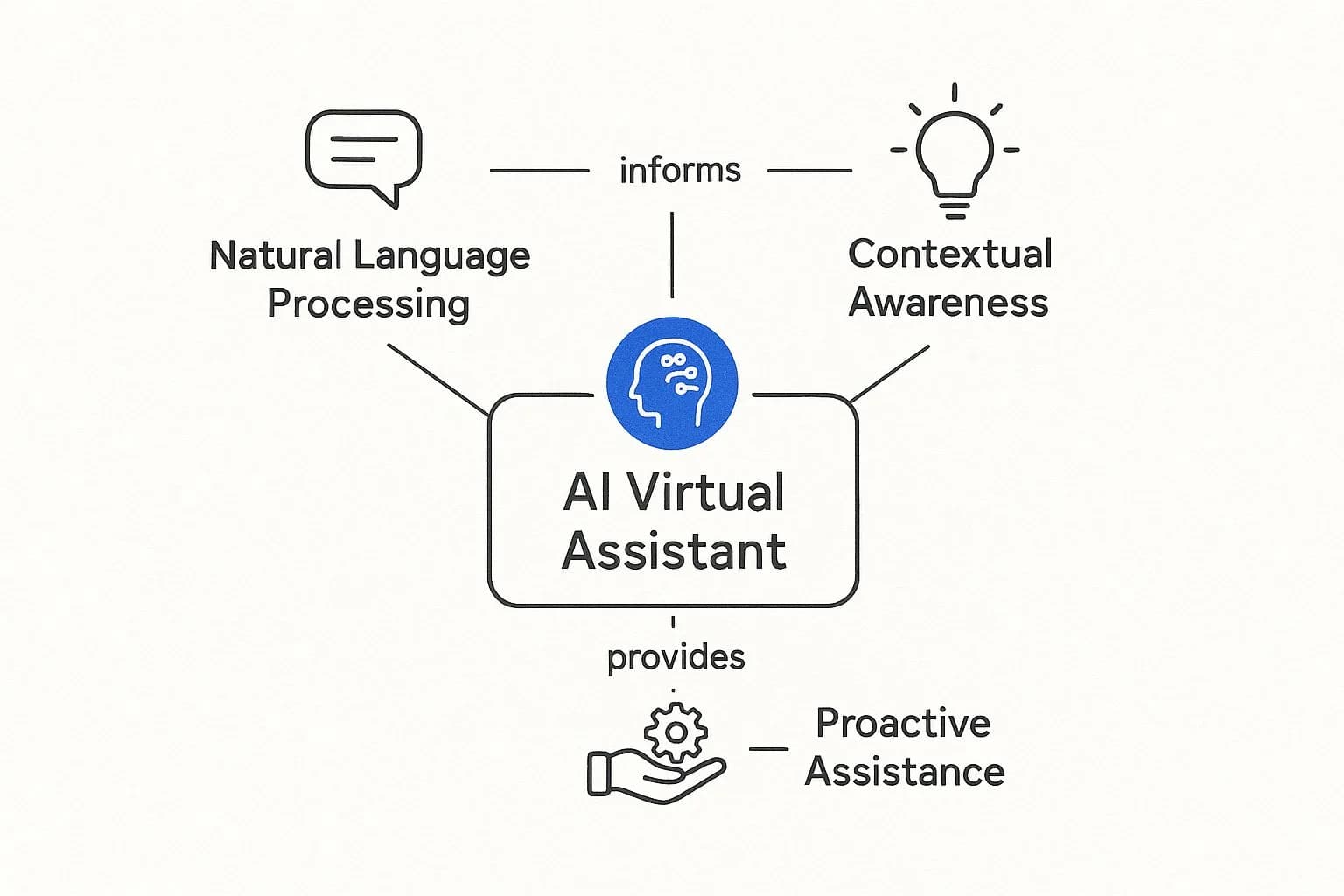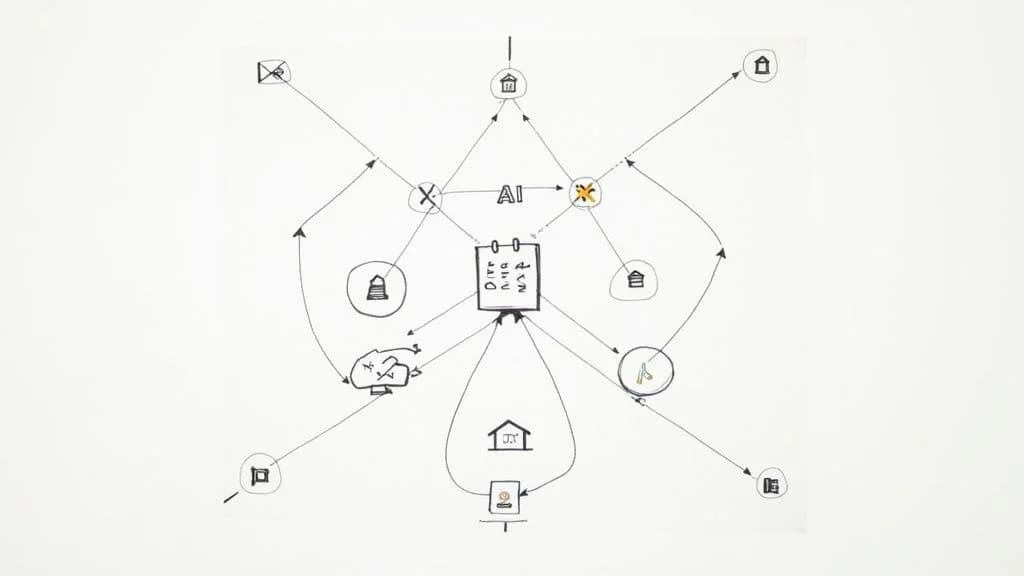How to Use an AI Powered Virtual Assistant to Grow Your Business

17 mins read
Picture a team member that works 24/7, answers thousands of customer questions instantly, and never needs a coffee break. That’s what an AI-powered virtual assistant brings to your business today. This isn't a future concept; it's a practical, actionable tool that smart companies are using to gain a competitive edge. This guide provides actionable insights on how to leverage this technology for real growth.
Why Every Business Needs a Digital Teammate
Today’s customers expect instant, accurate responses. An AI-powered virtual assistant is your first line of defense—a tireless problem-solver that provides consistent, reliable answers for your customers and internal teams.
It’s more than a simple chatbot; it’s a digital teammate. While older chatbots follow rigid, pre-written scripts, modern AI assistants understand context, learn from conversations, and tackle complex questions with surprising accuracy.
This shift creates a clear opportunity to rethink operations. By automating repetitive tasks, you free up your human experts to focus on strategic work and high-value customer relationships that require a personal touch.
The Growing Demand for Intelligent Automation
The move toward these digital teammates is a major market shift driven by the need for efficiency and better customer experiences. The data confirms this trend.
According to Fortune Business Insights, the virtual assistant market was valued at USD 15.3 billion in 2023. It's projected to explode to an estimated USD 51.0 billion by 2027. This demonstrates strong business confidence in this technology.
This growth is fueled by tangible results. Companies are seeing measurable improvements that directly impact their bottom line, making the adoption of an AI-powered virtual assistant a critical move to stay competitive.
To make this actionable, focus on solving these core business needs:
- Provide Immediate 24/7 Support: Offer instant answers to customers anytime, anywhere.
- Scale Efficiently: Handle thousands of concurrent conversations without the cost of hiring and training a massive support team.
- Improve Cost Efficiency: Reduce operational costs tied to routine inquiries, freeing up budget for strategic initiatives.
- Gather Data-Driven Insights: Treat every conversation as a data source to understand customer needs and pain points.
Beyond Customer Service
While customer support is the most obvious application, the impact of an AI-powered virtual assistant extends across the entire organization. From streamlining HR processes to qualifying sales leads, these tools are becoming central to modern business operations.
For example, an AI assistant can help sales teams schedule demos or provide product info to prospects instantly. Internally, it can assist employees in finding company policies or getting IT help without creating a new ticket. Platforms like IllumiChat are built to integrate this capability seamlessly into your existing workflows.
Ultimately, understanding and implementing this technology is essential for future-proofing your business and unlocking new levels of growth.
How AI Assistants Actually Understand and Interact
The key difference between a sophisticated AI powered virtual assistant and a basic chatbot is its ability to grasp nuance, context, and intent—not just keywords. This "brain" transforms a frustrating, dead-end interaction into a genuinely helpful conversation.
Think of it as the difference between a calculator and a financial advisor. The calculator needs precise inputs. The advisor listens, understands the why behind your questions, and offers relevant guidance. A great AI assistant emulates the advisor, using a stack of smart technologies to bridge the gap between human language and machine logic.
This is how the core components work together.

The real power comes from combining language skills (NLP), an understanding of the bigger picture (Contextual Awareness), and the ability to offer help before it’s even asked (Proactive Assistance).
Let’s look at the core technologies driving these capabilities.
Core Technologies Powering AI Virtual Assistants
Here’s a practical breakdown of the core AI technologies, their functions, and their direct business impact.
| Technology | What It Does in Simple Terms | Example Business Impact |
|---|---|---|
| Natural Language Processing (NLP) | Acts as a universal translator, turning messy human language into structured data a computer can process. | A customer can type "my order's late" instead of searching for a "Track Order" button, reducing friction and speeding up resolutions. |
| Machine Learning (ML) | Allows the assistant to learn from every interaction, spotting patterns and improving its answers over time without manual coding. | If an answer to "does this work with Model X?" consistently satisfies users, the AI learns to prioritize that response, boosting accuracy. |
| Sentiment Analysis | Reads the emotional tone behind the words—detecting if a user is happy, confused, or frustrated. | If a customer types "this is a disaster," the AI can immediately escalate the chat to a human agent, preventing a bad situation from getting worse. |
| Contextual Awareness | Remembers what was said earlier in the conversation to keep the dialogue flowing naturally. | When a user asks "how much is it?" the AI knows "it" refers to the product they just asked about, avoiding repetitive questions. |
Let's unpack these a bit more.
Natural Language Processing: The Universal Translator
At the heart of any smart assistant is Natural Language Processing (NLP). It’s the engine that converts casual language into something a machine can act on. This is why a customer can say "Where's my stuff?" or "Update on my package?" and the assistant knows they mean "Track my order."
But NLP is more than just recognizing words; it’s about deciphering intent. It’s a core principle of conversational AI, focusing on creating a natural back-and-forth instead of a rigid, command-based interaction.
Machine Learning: Getting Smarter on the Job
If NLP provides the ears, Machine Learning (ML) provides a brain that learns. Like an employee who improves with experience, the assistant analyzes thousands of past conversations to identify what works.
For example, if it notices that customers asking about "Model X" are most satisfied when they receive a link to a specific compatibility chart, the ML model learns to offer that link first. This self-improvement cycle means the assistant becomes more effective over time without manual programming updates.
Actionable Insight: This transforms your AI assistant from a static tool into a dynamic asset that adapts to your customers' evolving needs.
Context and Emotion: The Human Touch
Finally, true intelligence requires understanding context and emotion. Modern assistants use sentiment analysis to gauge a user's mood—happy, confused, or frustrated. This allows the AI to adjust its tone or, more importantly, know when to escalate to a human agent.
By weaving these capabilities together, an AI powered virtual assistant does more than provide pre-canned answers. It understands, adapts, and interacts in a way that feels genuinely helpful, building trust and improving the customer experience with every conversation.
Driving Measurable Growth with AI Assistants

Understanding the technology is one thing, but turning it into business results is what truly matters. A well-implemented AI powered virtual assistant delivers specific, measurable outcomes that positively impact your bottom line.
The most immediate impact is typically in customer support. By automating routine questions, businesses significantly reduce operational costs. But this isn't just about saving money; it's a strategic shift.
When an AI assistant handles basics like "What are your hours?" or "How do I reset my password?", it frees your skilled human agents. They can transition from reading FAQs to solving complex, high-value problems that require a human touch.
Boosting Efficiency and Customer Satisfaction
This approach delivers a powerful combination: lower costs and happier customers.
An AI powered virtual assistant operates 24/7, providing instant answers without queues. This is a game-changer for customer satisfaction (CSAT) scores. Research consistently shows that faster problem resolution leads to increased customer loyalty.
Actionable Insight: An AI assistant's ability to scale support instantly is its key advantage. It can handle thousands of conversations at once during a sudden spike—something a human team could never do without massive overstaffing.
This scalability ensures consistent service quality, which builds significant customer trust.
From Cost Center to Strategic Asset
A great AI powered virtual assistant doesn't just answer questions; it listens. Every interaction is a data point that creates a clear picture of what your customers need, where they struggle, and how they behave.
This data is invaluable. By analyzing conversation logs, you can gain actionable insights:
- Identify Product Gaps: Are people constantly asking for a feature you don't have? This is direct feedback for your product team.
- Refine Marketing Messages: Are customers confused about a key benefit? It’s time to tweak your website copy.
- Improve Your Knowledge Base: If the AI repeatedly answers the same question, your FAQ or help documentation may not be clear or easy to find.
This feedback loop transforms your support function from a reactive cost center into a proactive engine for business growth, enabling smarter, data-backed decisions.
The Expanding Market for Virtual Assistance
Because the benefits are so tangible, adoption is exploding. This is a fundamental shift in business operations.
The global market for virtual assistants is on a steep upward trajectory. By 2025, it's expected to reach USD 4,624.26 million and then rocket to an estimated USD 18,317.53 million by 2032. This growth is fueled by customer demand for instant answers and wider adoption of smart tech. You can review these market projections and see what's driving the growth.
This rapid expansion shows why deploying an AI powered virtual assistant is a core component of building a business that can meet modern customer expectations and unlock new efficiencies.
Putting AI Virtual Assistants to Work
The real power of an AI-powered virtual assistant is demonstrated when it solves actual business problems. Let’s examine how these tools are being implemented in various industries.
Retail: Revolutionizing the Customer Journey
Imagine Sarah buys a new coffee maker online. A few days later, she wants to track her package. Instead of searching emails for a tracking number, she opens the chat widget on the retailer's site.
She types, "Where's my coffee maker?"
Instantly, the AI assistant replies: "Hi Sarah! Your order #12345 is out for delivery and should arrive today before 5 PM." Because the assistant is integrated with the order management system, it provides a perfect, personalized update. A week later, it proactively messages her: "Hope you're enjoying the coffee! Would you like to see our top-rated espresso beans that pair perfectly with your machine?"
Actionable Takeaway: The modern AI-powered virtual assistant acts as a personal concierge, handling routine tasks while also driving upsells with smart, timely recommendations. For more inspiration, explore a variety of other AI assistant use cases that drive business results.
Finance: Fortifying Security and Access
Consider a banking scenario. Late at night, Mark reviews his budget and spots an unrecognized transaction. The bank’s call center is closed, but its AI assistant is on duty.
Mark messages the assistant: "I see a charge for $95.50 from a store I don't know."
The assistant authenticates him, checks his transaction history, and flags the purchase as unusual. "We've placed a temporary hold on your card for your security, Mark," it replies. "A fraud specialist will contact you tomorrow morning. Would you like to review other recent transactions?"
Actionable Takeaway: In this case, the AI assistant takes immediate, protective action. It transforms customer anxiety into an experience of security, building trust even without a human agent.
This blend of proactive security and instant access is a game-changer in finance.
Healthcare: Creating Better Patient Connections
The healthcare industry is also being transformed. Managing appointments, medication schedules, and patient questions can overwhelm staff, leading to long waits and frustration.
An AI-powered virtual assistant can change this. A patient can schedule a check-up by saying, "I need to book my annual physical." The assistant checks the doctor's calendar, offers slots, and confirms the appointment in seconds.
The global health intelligent virtual assistant market, valued at USD 640.95 million in 2025, is projected to hit USD 4,680.01 million by 2034. This growth is driven by AI's ability to bridge the communication gap between providers and patients. You can discover more insights about this rapidly growing market.
This chart from Precedence Research illustrates the market's trajectory.
The data clearly indicates a massive increase in confidence from healthcare providers using AI to manage administrative tasks and improve patient engagement.
Actionable applications for patients include:
- Appointment Management: Book, reschedule, or cancel appointments without waiting on hold.
- Medication Reminders: Receive automated alerts to improve treatment plan adherence.
- Answering FAQs: Get instant answers to common questions about clinic hours, insurance, or pre-visit preparations.
By handling these routine yet critical tasks, the AI-powered virtual assistant frees up healthcare staff to focus on direct patient care, leading to better outcomes and a less stressful experience.
Choosing the Right AI Assistant for Your Business

Selecting the right AI powered virtual assistant starts with defining your business objectives, not with a list of technical features.
Think of it like hiring. You wouldn't start by reviewing resumes; you'd start by defining the role and what success looks like.
Actionable First Step: Before evaluating vendors, define your primary goals. Do you want to reduce support ticket volume by 25%? Qualify more leads? Decrease first-response time to under one minute?
Having specific, measurable goals provides a clear framework for evaluating whether a solution is a good fit.
Defining Your Must-Have Features
Once your goals are clear, create a checklist of essential features. Focus on the right features for your team, not the most numerous.
Key evaluation areas include:
- Integration Capabilities: An assistant is useless if it's siloed. Look for out-of-the-box integrations with your CRM, help desk, and internal knowledge bases. This is non-negotiable for delivering accurate, context-aware answers.
- Customization and Control: Can you tailor the assistant's personality to match your brand? How easily can you update its knowledge or change conversation flows without a developer?
- Scalability: The solution must grow with you. Ask vendors how their platform handles traffic spikes and what it takes to expand to new channels or languages.
A great AI powered virtual assistant should feel like a natural extension of your team.
Evaluating Vendors and Planning for Integration
With your requirements list, you can start evaluating vendors. Look beyond marketing buzz and focus on implementation, support, and security.
Actionable Insight: The best vendor is a partner, not just a software seller. They should offer clear onboarding guidance and ongoing support to ensure you get real value from their platform.
When comparing options, use a simple evaluation framework. Breaking down your needs and comparing AI assistant pricing models helps you make a data-driven decision.
Use this checklist to guide your vendor conversations.
AI Virtual Assistant Vendor Evaluation Checklist
This checklist helps you ask the right questions and compare solutions effectively, ensuring you choose a partner aligned with your business needs.
| Evaluation Criteria | Key Questions to Ask | Why It Matters for Your Business |
|---|---|---|
| Security & Compliance | How is our data isolated and protected? Do you offer compliance with standards like GDPR or SOC 2? | Protecting customer and company data is non-negotiable. You need a platform built with enterprise-grade security from day one. |
| Training & Onboarding | What does the setup process look like? What kind of training and support do you provide for our team? | A smooth implementation is key to getting a fast ROI. A clunky setup can kill your project before it even starts. |
| Analytics & Reporting | What metrics can we track? How can we see what customers are asking and measure the assistant's performance? | Without data, you can't improve. Good analytics help you understand your customers and fine-tune the assistant's effectiveness. |
| Human-in-the-Loop | How easy is it for a human agent to take over a conversation? Can agents review and correct AI responses? | AI is powerful, but a seamless handoff to a human is critical for complex or sensitive issues. This protects the customer experience. |
Choosing an AI powered virtual assistant is a major step toward building a more responsive business. By starting with clear goals, defining your must-haves, and vetting partners carefully, you can find a solution that not only solves today’s problems but also scales for the future.
The Future Isn't Just Automated, It's Proactive
The evolution of the AI powered virtual assistant is far from over. Today’s assistants are great at solving problems you bring them. Tomorrow’s will be predictive partners, anticipating needs before they arise.
The next major shift is hyper-personalization. Imagine an assistant that knows a customer’s entire history—purchases, support tickets, and browsing behavior. Instead of waiting for a question, it might offer a tip about a recently purchased product or an alert about a sale on an item they viewed. This transforms a support tool into a personal concierge.
Get Ready for Proactive and Multimodal Assistants
Proactive engagement will soon become the standard. Your assistant won’t just solve problems; it will actively prevent them.
This means initiating helpful conversations based on user behavior. For instance, if someone is stuck on your checkout page, the assistant can pop up with, "Having trouble? I can help you complete your order."
The future is also multimodal. A smart AI powered virtual assistant must meet customers on their preferred channels, seamlessly switching between:
- Text: For quick questions on a website or app.
- Voice: For hands-free, conversational help via smart speakers.
- Visuals: For showing product photos, how-to videos, or diagrams within the chat.
Actionable Takeaway: The goal is a frictionless experience. It should feel less like talking to a bot and more like working with a capable helper who uses the right format for the job.
Building a Business That's Ready for What's Next
Rapid advancements in voice AI are accelerating this field. As assistants become better at understanding natural, conversational language, they will integrate more deeply into our daily lives. Amazon’s push to make Alexa more conversational signals that the goal is an assistant that can handle complex, multi-step tasks without constant direction.
Integrating an AI powered virtual assistant is no longer just a fix for support tickets. It's a strategic move to build a smarter, more responsive company that is prepared for the next wave of customer expectations.
Frequently Asked Questions
Considering an AI assistant for your business? Here are answers to common questions.
How Much Does an AI Powered Virtual Assistant Cost?
The cost of an AI powered virtual assistant depends on its capabilities. A simple FAQ bot may have a small monthly fee. A sophisticated platform that integrates with your CRM, automates complex workflows, and improves over time is a larger investment.
Most modern solutions are subscription-based, with pricing typically based on:
- The number of conversations handled per month.
- The complexity of required integrations.
- The level of customization and support needed.
How Long Does Implementation Take?
Modern AI assistant deployment is fast. A new AI powered virtual assistant can be operational in days or weeks, not months.
The timeline depends on two main factors: the amount of information the assistant needs to learn and the number of systems it needs to integrate with. Platforms with pre-built connectors can significantly accelerate the process.
Will an AI Assistant Replace My Human Support Team?
No, it empowers them. An AI assistant acts as a force multiplier for your team by handling high-volume, repetitive questions.
This frees your human agents to apply their expertise to complex customer issues that require a human touch and build stronger customer relationships.
Actionable Insight: View the AI as a brilliant assistant for your best agents. It manages routine tasks, allowing your experts to focus on solving problems that drive customer loyalty.
Ready to see how an AI-powered virtual assistant can unify your client knowledge and deliver faster resolutions? Discover IllumiChat, the AI support platform built for MSPs and integrators.
Explore IllumiChat.
Ready to Transform Your Support with AI?
Join thousands of teams already using IllumiChat to deliver faster, more accurate support. Start your free trial today or subscribe for the latest AI insights.
No credit card required • Setup in under 30 minutes • Cancel anytime